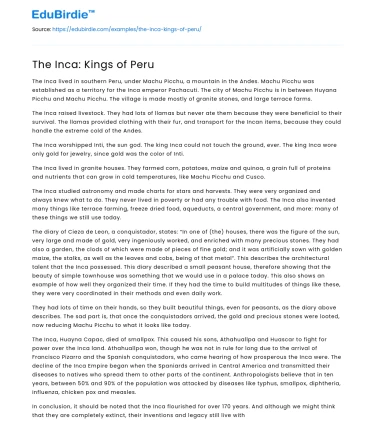The Inca lived in southern Peru, under Machu Picchu, a mountain in the Andes. Machu Picchu was established as a territory for the Inca emperor Pachacuti. The city of Machu Picchu is in between Huyana Picchu and Machu Picchu. The village is made mostly of granite stones, and large terrace farms.
The Inca raised livestock. They had lots of llamas but never ate them because they were beneficial to their survival. The llamas provided clothing with their fur, and transport for the Incan items, because they could handle the extreme cold of the Andes.
Save your time!
We can take care of your essay
- Proper editing and formatting
- Free revision, title page, and bibliography
- Flexible prices and money-back guarantee
The Inca worshipped Inti, the sun god. The king Inca could not touch the ground, ever. The king Inca wore only gold for jewelry, since gold was the color of Inti.
The Inca lived in granite houses. They farmed corn, potatoes, maize and quinoa, a grain full of proteins and nutrients that can grow in cold temperatures, like Machu Picchu and Cusco.
The Inca studied astronomy and made charts for stars and harvests. They were very organized and always knew what to do. They never lived in poverty or had any trouble with food. The Inca also invented many things like terrace farming, freeze dried food, aqueducts, a central government, and more: many of these things we still use today.
The diary of Cieza de Leon, a conquistador, states: “In one of (the) houses, there was the figure of the sun, very large and made of gold, very ingeniously worked, and enriched with many precious stones. They had also a garden, the clods of which were made of pieces of fine gold; and it was artificially sown with golden maize, the stalks, as well as the leaves and cobs, being of that metal”. This describes the architectural talent that the Inca possessed. This diary described a small peasant house, therefore showing that the beauty of simple townhouse was something that we would use in a palace today. This also shows an example of how well they organized their time. If they had the time to build multitudes of things like these, they were very coordinated in their methods and even daily work.
They had lots of time on their hands, so they built beautiful things, even for peasants, as the diary above describes. The sad part is, that once the conquistadors arrived, the gold and precious stones were looted, now reducing Machu Picchu to what it looks like today.
The Inca, Huayna Capac, died of smallpox. This caused his sons, Athahuallpa and Huascar to fight for power over the Inca land. Athahuallpa won, though he was not in rule for long due to the arrival of Francisco Pizarro and the Spanish conquistadors, who came hearing of how prosperous the Inca were. The decline of the Inca Empire began when the Spaniards arrived in Central America and transmitted their diseases to natives who spread them to other parts of the continent. Anthropologists believe that in ten years, between 50% and 90% of the population was attacked by diseases like typhus, smallpox, diphtheria, influenza, chicken pox and measles.
In conclusion, it should be noted that the Inca flourished for over 170 years. And although we might think that they are completely extinct, their inventions and legacy still live with their descendants.
References
- Anderson, Dale, and World Book. The Inca. Chicago, World Book, 2009.
- Garbe, Suzanne. Secrets of Machu Picchu : Lost City of the Incas. North Mankato, Minnesota, Capstone Press, 2015.
- History.com Editors. “Inca”. HISTORY, 21 Aug. 2018, www.history.com/topics/south-america/inca.
- Jarus, Owen. “The Inca Empire”. Live Science, Live Science, 5 Nov. 2018, www.livescience.com/41346-the-incas-history-of-andean-empire.html.
- Machu Picchu Tours. “10 Best Machu Picchu Tours and Peru Travel Packages.” Machupicchu.Com, 20 Feb. 2018, machupicchu.com.
- Parker, Edward. Peru. Austin, Tex., Raintree Steck-Vaughn, 1997.
- Samuels, Charlie. Technology in the Ancient Americas. New York, Ny, Gareth Stevens Publishing, 2014.
- Trup, Nicola, and Ben Lerwill. Peru- From the Andes to the Amazon. UK, National Geographic, 2014.
- Writer, Staff. “The Fall of the Inca Empire | Discover Peru”. Discover-Peru.Org, 2019, www.discover-peru.org/the-fall-of-the-inca-empire/.






 Stuck on your essay?
Stuck on your essay?

